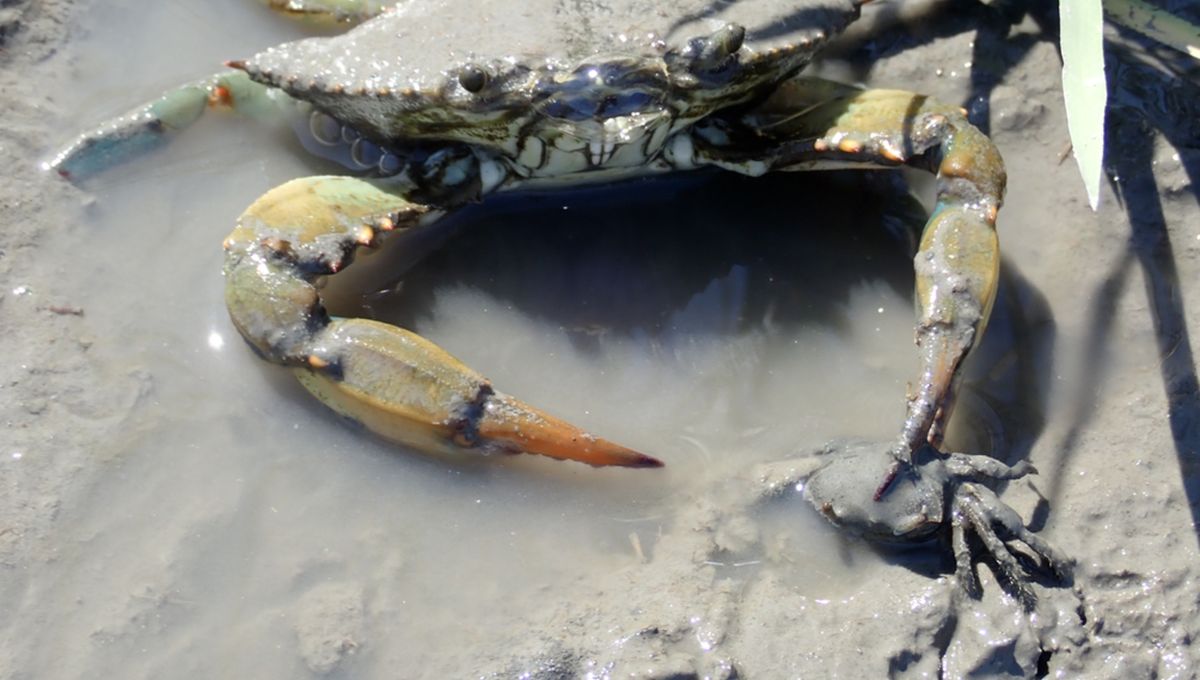
Believed to be the first recorded behavior of its kind, blue crabs (Callinectes sapidus) have been observed ambushing fiddler crabs (Minuca pugnax) in a salt marsh in Virginia, USA. The findings are published in the journal Ecology.
Blue crabs are an aquatic species, with their Latin name Callinectes literally translating as “beautiful swimmer”. However, these cunning crustaceans have found a way to hunt when the tide has gone out. By digging down into the mud, they create shallow, water-filled pools, and lie in wait. Any unsuspecting fiddler crabs going about their crabby business who wander too close risk being ambushed by blue crabs who want to gobble them up.
Dr David Johnson, the new study’s author and ecologist at William & Mary’s Virginia Institute of Marine Science, explains in a statement, “It was amazing because here was an aquatic predator – one that lives, eats, breathes, and breeds under water – feeding out of the water,” says Johnson. “It was like crocodiles ambushing wildebeests in Africa.”
Apart from a small amount of anecdotal evidence, this behavior had not been recorded before. It was known that fiddler crabs were fed on by the blues during high tide. However, at low tide, it was thought the fiddler crabs hid away in their burrows while the blue crabs ate algae and scavenged while the tide was out.
“Blue crabs have been known to dash a few feet onto land to snatch fiddler crabs before returning to the water to dismember and eat them,” says Johnson, “But the behavior we saw was different. Blue crabs were not chasing their prey on land; they were waiting on land for their prey to come to them. It’d be like if you went to an Italian restaurant and were suddenly dragged under the table by a giant octopus.”
Two weeks after their initial observations, Johnson and his team returned to the marsh to find out more specifics about the crab’s behavior. They discovered that the pools were being used by 83 percent of juvenile crabs, and video evidence helped lead to the conclusion that the crabs were digging the pools themselves. The juveniles showed no loyalty to any one pool in particular and were open to moving pools – turfing out the current resident in the process.
Furthermore, the crabs’ ambushing tactic was relatively successful, with 11/31 attacks captured in the 37 hours of video footage ending with a satisfied blue crab and a fiddler crab as lunch. The blue crabs even tried to steal the fiddler crabs from each other. Johnson described the scene surrounding the successful pools as “like the discarded bones of villagers outside a dragon’s lair.”
Johnson thinks the success of the blue crabs might be in part due to the helping hand – or should we say claw – of another crab species. The purple marsh crab (Sesarma reticulatum), feeds on cordgrass, making the area more open and therefore easier for the blue crabs to dig their ambush pools.
The team plans to study the crab behavior more to see if it is present in other aquatic species, and also plan to investigate the camouflage aspect of the blue crabs hiding from avian predators.
Source Link: Watch Never-Before-Seen Footage Of Blue Crabs Ambushing Their Brethren